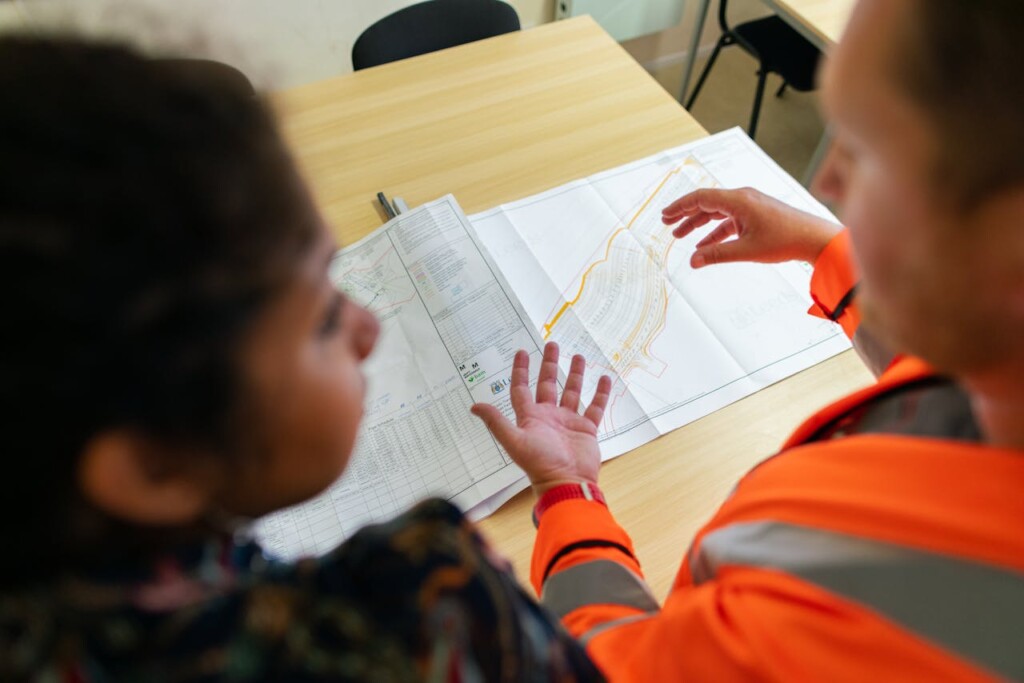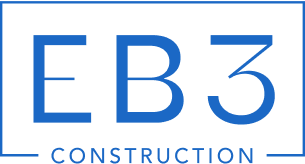Every construction project starts with a single fact: one miscommunication can cost thousands in rework and weeks in delays. The client-contractor communication process forms the structured flow of information between all project stakeholders, creating the foundation for successful project delivery.
We coordinate information exchange between clients, design professionals, field crews, and subcontractors through documented channels that align expectations from day one. Transparent updates build the trust that keeps projects moving forward while supporting quality assurance and safety through shared awareness of site conditions and project changes.
How Should Roles And Chain Of Command Be Defined?

We establish construction project hierarchy at the contract stage. Contract documents form the foundation that determines communication pathways and authority levels across the entire project team.
The architect typically serves as the primary conduit between owner and contractor. This routing structure prevents mixed messages and maintains professional boundaries established in the original agreement.
Establish Clear Points Of Contact
We designate specific individuals for different project aspects. The superintendent handles all field operations and site-related decisions.
Project managers coordinate overall progress and client relations. Subcontract coordinators manage trade-specific communications and scheduling conflicts.
Each role carries defined responsibilities that prevent overlap and confusion. We document these assignments in writing so all parties understand who addresses specific issues.
Create Written Communication Protocols
Our communication plan outlines meeting schedules, reporting formats, and escalation procedures. Regular coordination meetings bring together key personnel weekly or biweekly depending on project complexity.
Daily reporting follows standardized templates that capture progress, issues, and resource needs. This consistency allows quick identification of trends and potential problems.
Escalation steps provide clear pathways when field decisions exceed established authority levels. Minor adjustments flow through the superintendent while major changes require project manager and client approval.
Define Authorization Boundaries
We specify which team members can approve different types of decisions. Field changes under predetermined dollar amounts may proceed with superintendent approval.
RFIs and specifications clarifications follow formal channels through the architect. Change orders require written authorization from designated project stakeholders before work begins.
Any communication outside these established pathways requires explicit permission and documentation. This protects all parties from unauthorized commitments or scope modifications.
Direct owner-subcontractor communication needs prior approval and creates written records. These controls maintain contract integrity while allowing necessary project flexibility.
Which Channels, Cadence, And Records Keep Teams Aligned?
We choose communication channels based on message complexity and urgency. Simple status updates work through email, while complex technical issues require face-to-face meetings or calls where teams can ask questions immediately. Formal project documents like RFIs, submittals, and change orders need structured forms that create clear paper trails.
Match Communication Medium To Message Type
Quick coordination messages travel through email or text. These work for schedule updates, minor clarifications, or brief status confirmations that require simple responses.
Complex discussions demand real-time interaction. When we encounter technical challenges, design conflicts, or budget concerns, we schedule calls or meetings. Phone conversations allow immediate feedback and prevent misunderstandings that email chains often create.
Formal documentation requires structured processes. RFIs average 9.7 days for responses, making efficient tracking essential for project momentum. We use standardized forms for RFIs, submittals, and change orders to ensure complete information capture and proper approval workflows.
Establish Consistent Reporting Rhythms
Daily logs capture field conditions, weather impacts, and work progress. We standardize these reports across crews to track labor hours, equipment usage, and completed tasks consistently.
Progress photos document visual milestones and quality benchmarks. We schedule regular photo updates at predetermined project phases, creating visual records that support both client updates and potential dispute resolution.
Field reports combine daily observations with safety incidents and material deliveries. These centralized reports help us track project health and identify emerging issues before they impact schedules.
Centralize Project Information Systems
We maintain single sources of truth for all project documents. Current drawings, specifications, and contract modifications live in accessible digital repositories where team members always work from the latest versions.
Shared schedules prevent coordination conflicts between trades. We update these schedules weekly during coordination meetings, ensuring subcontractors understand sequence dependencies and critical path activities.
Communication logs preserve decision rationale and approval history. We document who said what, when they said it, and why decisions were made to support future reference and accountability.
Schedule Regular Coordination Touchpoints
Weekly coordination meetings align subcontractor schedules and resolve upcoming conflicts. We keep these meetings focused on logistics, sequencing, and resource allocation rather than technical problem-solving.
Monthly progress reviews examine broader project health, including budget variance, schedule performance, and quality metrics. These meetings include key stakeholders and focus on strategic adjustments rather than daily operations.
Emergency communication protocols ensure rapid response to safety issues or critical path disruptions. We establish clear escalation paths and contact information for urgent situations requiring immediate attention.
How Are Changes, Scope, And Safety Managed Through Communication?

We manage project changes through structured documentation that connects every modification to its cost and schedule impacts. Change orders require detailed records that capture the specific work requested, reasons for the change, and all necessary approvals before implementation begins.
Each change order documents the requesting party, technical specifications, material requirements, and labor adjustments. We link these modifications directly to budget implications and timeline adjustments so stakeholders understand the full project impact. Written approvals from authorized personnel prevent unauthorized work and protect all parties from disputes.
Maintaining Client Transparency
We keep clients informed through documented updates paired with visual progress photos. Regular communication includes current project status, completed milestones, and any issues requiring attention or decisions. Progress photos provide clear evidence of work quality and completion stages.
Client updates follow a consistent format that covers schedule adherence, budget status, and upcoming activities. We document all communications to create a clear project timeline that serves both immediate coordination needs and future reference. This transparency builds trust and enables proactive decision-making.
Preventing Scope Creep
We prevent scope creep by referencing signed contract documents before committing to any additional work. When requests arise that fall outside the original scope, we pause work discussions to review the existing agreements and specifications. This approach protects both our team and clients from unplanned costs.
Before accepting new tasks, we verify whether the work appears in the original drawings, specifications, or approved change orders. Any work not explicitly covered requires formal change order processing with impact assessment and written approval. This systematic approach prevents costly disputes and project delays that commonly arise from unclear scope boundaries.
Safety Communication Protocols
We support site safety through clear briefings, timely safety bulletins, and real-time hazard alerts. Safety communication flows both ways, encouraging field crews to report concerns immediately rather than waiting for formal meetings. Daily safety briefings address current conditions, weather impacts, and any new hazards identified.
Safety bulletins distribute critical information about regulatory changes, equipment updates, or incident learnings from other projects. We issue hazard alerts for immediate threats like utility conflicts, structural concerns, or environmental conditions. These communications reach all team members through multiple channels to ensure rapid response.
Two-way reporting systems enable crews to raise safety concerns, identify potential risks, and suggest improvements without fear of delays or criticism. We document safety communications to track issue resolution and demonstrate our commitment to worker protection and regulatory compliance.
What Daily Behaviors Improve Clarity and Trust With Clients?
Strong client relationships grow from consistent daily behaviors that demonstrate professionalism and commitment. We focus on habits that build trust through clear communication and reliable follow-through. These behaviors create the foundation for long-term partnerships and successful project outcomes.
Practice Active Listening and Confirm Understanding
Active listening requires full attention to what clients are saying, not just waiting for our turn to respond. We maintain eye contact during meetings, ask clarifying questions, and avoid interrupting when clients express concerns or feedback. This approach helps us understand the full context behind their requests and concerns.
Confirming understanding closes the communication loop effectively. We paraphrase what we heard and ask clients to verify our interpretation before moving forward. For example, after discussing a design modification, we might say, “So we’re adjusting the window placement to improve natural light in the conference room, and you’d like to see updated drawings by Friday. Is that correct?” This verification prevents costly misunderstandings down the line.
Two-way communication strengthens when we create space for client questions and concerns. We schedule regular check-ins and encourage clients to raise issues as they arise rather than waiting for formal meetings. This proactive approach builds confidence and demonstrates our commitment to their project success.
Keep Messages Clear and Professional
Clear and concise communication eliminates confusion and shows respect for everyone’s time. We avoid construction jargon when speaking with clients, explaining technical terms when necessary. Instead of saying “we need to coordinate MEP rough-in before the drywall subs mobilize,” we explain that “we’re scheduling electrical, plumbing, and HVAC installations before the wall finishing begins.”
Professional tone in all communications reflects our company’s standards and expertise. Written messages stay fact-focused and objective, presenting information without emotional language or assumptions. We state what happened, what we’re doing about it, and what clients can expect next. This approach maintains professionalism even when discussing challenging situations.
Progress visuals support our written and verbal updates by showing rather than just telling. We include photos, drawings, and simple charts that illustrate current conditions and upcoming work. Visual documentation helps clients understand complex construction sequences and builds confidence in our progress.
Provide Predictable Updates and Explanations
Client expectations improve when they know when and how they’ll receive project updates. We establish regular communication rhythms at project start, such as weekly progress reports and monthly meetings. Consistency in timing and format helps clients plan their own schedules and stay informed without having to ask for updates.
Explaining reasons for changes builds trust and demonstrates our expertise. When weather delays concrete pours or supplier issues affect material deliveries, we explain the impact on schedule and budget along with our response plan. Clients appreciate understanding the “why” behind decisions and delays, even when the news isn’t ideal.
Feedback loops ensure clients can raise questions and concerns without delay. We create multiple channels for client input, from daily site conversations to formal written responses. Regular surveys or check-ins help us gauge client satisfaction and address issues before they escalate. Research shows that effective feedback loops strengthen client engagement and build long-term loyalty by making clients feel heard and valued throughout the process.
Conclusion and Next Steps

Effective client-contractor communication operates as an integrated system where each component reinforces the others. We establish defined roles through clear chain of command structures, select appropriate channels that match message complexity, maintain steady cadence through scheduled reporting, and keep complete records of all interactions. This foundation supports transparent client updates while maintaining rigorous change control processes that protect project scope and budget.
Implementation begins with concrete steps that create immediate structure. Start by writing a comprehensive communication plan that outlines who communicates what, when, and through which channels. Set meeting rhythms that provide predictable touchpoints for progress updates and issue resolution. Centralize all project documents in a shared system where teams and clients access the same current information from kickoff through closeout. When we systematize communication this way, we reduce misunderstandings, build stronger client relationships, and deliver projects that meet expectations on schedule and within budget.
Ready to implement a structured communication process for your next project? Contact EB3 to discuss how we can support your development goals with clear, consistent project communication.




